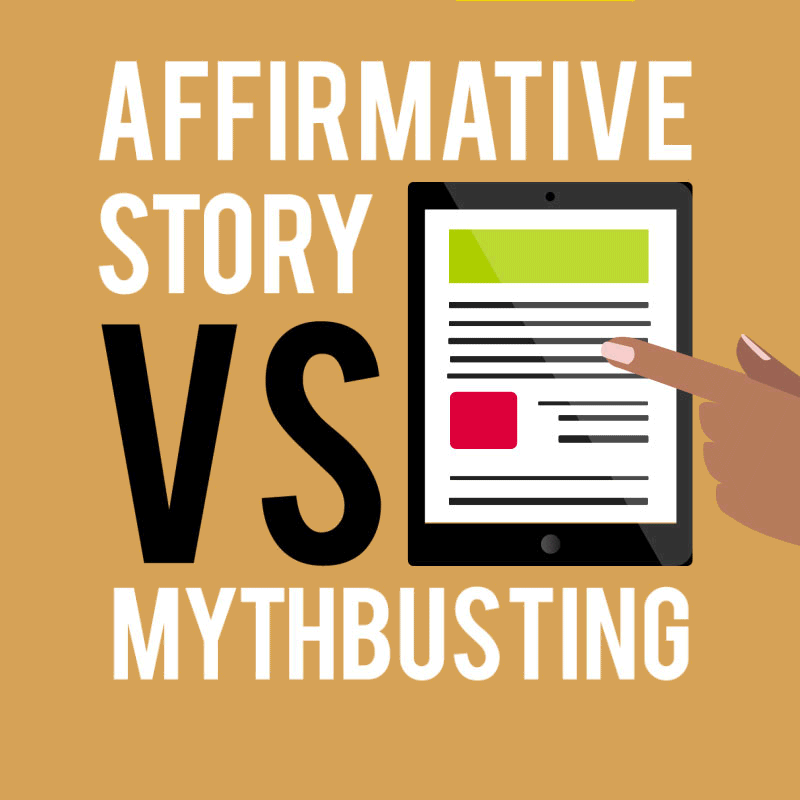Telling a New Story
Social justice leaders across the country increasingly recognize the power of narrative strategies to shape hearts and minds on the most critical issues of our time. Narrative strategies commonly refer to shaping the story told about social and political issues to mobilize public will for change. This is often done through the use of mass media, but can also include art production and cultural strategies, community organizing, research and publishing, educational tactics, and all strategies intended to persuade individuals or groups toward a new understanding of social issues.
Any social justice leader who has attempted to use these strategies to affect social change knows that it’s a complex undertaking. Time and time again, social justice leaders working across the lines of difference struggle with developing narratives that don’t sacrifice long-term vision for short-term gains, push under-represented voices to the margins, position race and class in opposition, or worse―undermine allies. These challenges aren’t the fault of a few bad actors. Be it social position, geographic scope, issue, constituency base, or methodology―communicating strategically across diverse interests to build new majorities and win on issues of rights, equity, and justice can push the most well-intentioned leader into difficult compromises.
This checklist was developed to provide social justice leaders at every level with a set of guiding principles and a checklist that ensures, above all else, our messaging and framing strategies do not sacrifice each other in the social change process. The checklist emerges from a 2013 convening on social justice communications strategies hosted by The Opportunity Agenda and the Center for Media Justice, and was developed by a working group including progressive organizations from across the country that use narrative strategies as a primary tool for social change.
1. First, Do No Harm
The first, and most important, principle guiding this checklist is Do No Harm. “Do No Harm” refers to the principle that our organizational and campaign narratives should never fundamentally undermine the work of partners and allies in shared efforts for lasting change, even when managing competing needs and interests. The following considerations take relationships and the political landscape on an issue into account, rather than ignoring them, to ensure our messaging remains coordinated.
Checklist
- Is your organization familiar with the messaging landscape on your issue(s)?
- Have allied organizations worked together to identify broad themes or values that inform core messaging?
- If you are working in coalition, has message development been a participatory process? Do all members feel a sense of collective ownership over the messaging?
- For joint projects, are there clearly defined organizational roles? Do all allied groups agree on implementation strategy?
- If disagreements about messaging, strategy, or priorities exist, have you had thoughtful conversations with concerned parties to determine the source of disagreement? Are you willing to adjust your strategy?
Tips
- Elevate the successes of partners and continue to educate others, especially funders, about the challenges and strengths of collaboration.
- When countering oppositional messages or wedge strategies, be careful not to reinforce their worldview. Also consider how your message could be co-opted by your opposition.
- If disagreements are minor, determine how best to align and compromise, and use effective language in messaging that doesn’t undermine your allies.
- Manage competing interests through consensus-building processes, rather than allowing interests with the most power to lead.
2. Critique Government without Undermining Democracy
“If the surgeon himself thinks his tools are rancid, why shouldn’t you?” ―David Brooks
For social justice leaders working on public policy issues, it’s of critical importance that our narrative strategies are powerful enough to hold government accountable, while not playing into anti-government themes that seek to privatize, shrink, or otherwise weaken the democratic process. Our narratives should not make excuses for government or debate its size, but rather uplift the fundamental role of government and its benefits while still highlighting the need for change and a vision for greater democracy. Check the list as you communicate strategically about government.
Checklist
- Does your messaging critique specific governmental practices or policies, while including a vision for what good governance might look like?
- Does your messaging explain how public infrastructure and systems benefit us all and depend upon us all to create a better future?
- Does your messaging use core values to contrast the promise against the reality of public infrastructure, policies, or practices while maintaining the value of the public system itself?
Tips
- When messaging about government, foreshadow a vision of what good governance looks like. Progressives often talk about governance in relation to corrupt politicians, bad policies, or as a bureaucratic mess. These trigger negative stereotypes about government rather than creating an entry point to a discussion about what governance should look like and how we can get there.
3. Support Lasting Change: Prioritize Strategy and Collaboration over Expediency
How we win matters. That’s why it’s important to define, together, what winning looks like in advance of a campaign; it’s also crucial to allow the principles of interdependence, equity, and collective power to guide the process. When deploying narrative strategies, social justice leaders must balance the need to win concrete changes immediately and advance a long-term vision for more fundamental change, rather than sacrificing one for the other. It’s a careful balancing act, but if we are guided by our deeply felt values and long-term vision we can build messaging campaigns that win today and lay the groundwork for future wins. Check the list to see if your narrative strategies frame lasting change.
Checklist
- Thinking of audiences, is your strategy directed at marginalizing the opposition, moving the middle, or expanding the base? Long-term strategies consider the affect of the campaign on each audience.
- Are the shared values and framing strategies strong enough to translate across unexpected and continuous changes in media, policy, elections, and “politics”?
- Alternatively, if and when the frame is narrowly focused on eliciting a specific action, can that frame stand alone in an emblematic or symbolic way that translates across time?
- Is the frame capable of withstanding future or anticipated opposition or criticism?
- Is the frame purposed, tested, and proven to change attitudes and mindsets long-term?
- Have you done sufficient planning to determine whether your chosen narrative helps your campaign but also advances long-term goals? If you choose to lean on a strategy that accomplishes one of those objectives, would it interfere with objectives in the future?
Tips
- Discuss and flesh out your vision for the future and create messages and campaigns that point toward this vision.
- Beware centrist strategies. Deliberately decide to expand the base or move the middle.
- Be aware of how your strategy works with others who are addressing similar issues, but with different audiences.
4. Consider Context, History, and Landscape
Words are meaningful―but meaning is created by more than words. Narratives emerge from their context, history, and relations to power. Our narratives are most powerful when they create a new story using universal values that have stood the test of time. Social justice leaders should reclaim and re-frame these values, and use them to wedge the opposition while building a bigger “us.” To use values effectively, social justice leaders can give old values new context, and mobilize them with built power, to produce new meaning. Check the list to see how.
Checklist
- Do your narrative strategies adequately highlight patterns of inequity and privilege, track trends, and uplift the social, political, or economic context of the targeted issue?
- Do your narrative strategies simply state universal values in a way that reinforces old, dominant, negative, or oppositional frames, or do they give these shared values new meaning?
Tips
- Conduct research and story collection on historic patterns, and use metaphors, symbols, and action to demonstrate their impact on the targeted issue or constituency.
5. The Question of Attribution: Give Credit Where Credit Is Due
Too often, the fast pace and power dynamics of campaigns can make us forget to give credit for new ideas, successful interventions, and resource generation or coordination. Sometimes, social movements swing between rejecting the newest voices at the table or the oldest ones. Attributing success appropriately can result in new resources and relationships, and greater visibility and investment for all. In deploying your narrative strategies, are you giving credit where credit is due? Check the list to find out.
Checklist
- Have partners at the table contributed to or led to successful impacts or benchmarks achieved?
- Has the work of those partners been highlighted, and attribution appropriately given, in press hits hits, social media, and the policy foray?
- Will giving attribution to a particular group or type of groups strengthen the campaign, sector, or movement?
- Has prejudice or bias prevented appropriate attribution in the past? Are there protocols and practices in place to avoid that pattern now?
Tips
- For joint projects―clearly outline at the start of the project how you will describe everyone’s role to outside stakeholders (funders, partners, etc.). Agree how to tell the story of the project.
- Elevate the success of collaborative efforts, especially to funders, in telling the story about the importance and challenges of collaboration.



